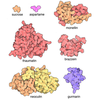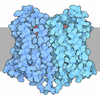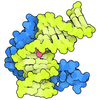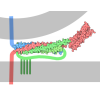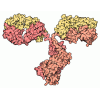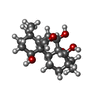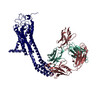+ Open data
Open data
- Basic information
Basic information
| Entry | Database: PDB / ID: 9dnm | |||||||||||||||||||||
|---|---|---|---|---|---|---|---|---|---|---|---|---|---|---|---|---|---|---|---|---|---|---|
| Title | Structure of rat beta-arrestin 1 bound to allosteric inhibitor | |||||||||||||||||||||
 Components Components |
| |||||||||||||||||||||
 Keywords Keywords | SIGNALING PROTEIN/Immune System / GPCR signaling / arrestin / allostery / SIGNALING PROTEIN / SIGNALING PROTEIN-Immune System complex | |||||||||||||||||||||
| Function / homology |  Function and homology information Function and homology informationV2 vasopressin receptor binding / alpha-1A adrenergic receptor binding / follicle-stimulating hormone receptor binding / TGFBR3 regulates TGF-beta signaling / sensory perception of touch / G alpha (s) signalling events / regulation of inositol trisphosphate biosynthetic process / follicle-stimulating hormone signaling pathway / protein phosphorylated amino acid binding / alpha-1B adrenergic receptor binding ...V2 vasopressin receptor binding / alpha-1A adrenergic receptor binding / follicle-stimulating hormone receptor binding / TGFBR3 regulates TGF-beta signaling / sensory perception of touch / G alpha (s) signalling events / regulation of inositol trisphosphate biosynthetic process / follicle-stimulating hormone signaling pathway / protein phosphorylated amino acid binding / alpha-1B adrenergic receptor binding / Lysosome Vesicle Biogenesis / AP-2 adaptor complex binding / Ub-specific processing proteases / angiotensin receptor binding / MAP2K and MAPK activation / Golgi Associated Vesicle Biogenesis / Cargo recognition for clathrin-mediated endocytosis / clathrin adaptor activity / Clathrin-mediated endocytosis / negative regulation of interleukin-8 production / regulation of G protein-coupled receptor signaling pathway / cysteine-type endopeptidase inhibitor activity involved in apoptotic process / arrestin family protein binding / G protein-coupled receptor internalization / mitogen-activated protein kinase kinase binding / Thrombin signalling through proteinase activated receptors (PARs) / response to morphine / clathrin binding / stress fiber assembly / positive regulation of Rho protein signal transduction / pseudopodium / negative regulation of interleukin-6 production / positive regulation of receptor internalization / negative regulation of Notch signaling pathway / phototransduction / positive regulation of insulin secretion involved in cellular response to glucose stimulus / insulin-like growth factor receptor binding / clathrin-coated pit / negative regulation of protein ubiquitination / GTPase activator activity / positive regulation of protein ubiquitination / nuclear estrogen receptor binding / phosphoprotein binding / electron transport chain / G protein-coupled receptor binding / negative regulation of ERK1 and ERK2 cascade / adenylate cyclase-modulating G protein-coupled receptor signaling pathway / endocytosis / positive regulation of protein phosphorylation / protein transport / cytoplasmic vesicle / ubiquitin-dependent protein catabolic process / regulation of apoptotic process / basolateral plasma membrane / dendritic spine / molecular adaptor activity / negative regulation of neuron apoptotic process / proteasome-mediated ubiquitin-dependent protein catabolic process / transmembrane transporter binding / postsynaptic membrane / transcription coactivator activity / periplasmic space / electron transfer activity / positive regulation of ERK1 and ERK2 cascade / endosome / positive regulation of MAPK cascade / postsynaptic density / protein ubiquitination / G protein-coupled receptor signaling pathway / iron ion binding / response to xenobiotic stimulus / signaling receptor binding / positive regulation of cell population proliferation / heme binding / ubiquitin protein ligase binding / regulation of DNA-templated transcription / regulation of transcription by RNA polymerase II / negative regulation of apoptotic process / chromatin / glutamatergic synapse / enzyme binding / positive regulation of transcription by RNA polymerase II / nucleus / plasma membrane / cytosol / cytoplasm Similarity search - Function | |||||||||||||||||||||
| Biological species |  Homo sapiens (human) Homo sapiens (human) | |||||||||||||||||||||
| Method | ELECTRON MICROSCOPY / single particle reconstruction / cryo EM / Resolution: 3.47 Å | |||||||||||||||||||||
 Authors Authors | Pakharukova, N. / Kahsai, A.W. / Masoudi, A. / Lefkowitz, R.J. | |||||||||||||||||||||
| Funding support |  United States, United States,  France, European Union, 6items France, European Union, 6items
| |||||||||||||||||||||
 Citation Citation |  Journal: bioRxiv / Year: 2025 Journal: bioRxiv / Year: 2025Title: Small-molecule modulation of β-arrestins. Authors: Alem W Kahsai / Natalia Pakharukova / Henry Y Kwon / Kunal S Shah / Jason G Liang-Lin / Caroline T Del Real / Paul J Shim / Mason A Lee / Van A Ngo / Bowie N Shreiber / Samuel Liu / Allison ...Authors: Alem W Kahsai / Natalia Pakharukova / Henry Y Kwon / Kunal S Shah / Jason G Liang-Lin / Caroline T Del Real / Paul J Shim / Mason A Lee / Van A Ngo / Bowie N Shreiber / Samuel Liu / Allison M Schwalb / Emmanuel F Espinoza / Brittany N Thomas / Cal A Kunzle / Jeffrey S Smith / Jialu Wang / Jihee Kim / Xingdong Zhang / Howard A Rockman / Alex R B Thomsen / Lindsay A M Rein / Lei Shi / Seungkirl Ahn / Ali Masoudi / Robert J Lefkowitz Abstract: β-arrestins are multifunctional regulators of G protein-coupled receptor (GPCR) signaling, orchestrating diverse downstream signaling events and physiological responses across the vast GPCR ...β-arrestins are multifunctional regulators of G protein-coupled receptor (GPCR) signaling, orchestrating diverse downstream signaling events and physiological responses across the vast GPCR superfamily. While GPCR pharmacology has advanced to target orthosteric and allosteric sites, as well as G proteins and GRKs, comparable chemical tools to study β-arrestins remain lacking. Here, we report the discovery of small-molecule inhibitors that selectively target β-arrestins and delineate their mechanism of action through integrated pharmacological, biochemical, biophysical, and structural analyses. These inhibitors disrupt β-arrestin-engagement with agonist-activated GPCRs, impairing desensitization, internalization, and β-arrestin-dependent functions while sparing G protein-receptor coupling. Cryo-EM, MD simulations, and structure-guided mutagenesis reveal that one modulator, Cmpd-5, engages a cryptic pocket formed by the middle, C-, and lariat loops of β-arrestin1-a critical receptor-binding interface-stabilizing a distinct conformation incompatible with GPCR engagement. Together, these findings provide a mechanistic framework for β-arrestin modulation, introducing transducer-targeted strategies to fine-tune GPCR signaling and guide the development of pathway-specific therapeutics. | |||||||||||||||||||||
| History |
|
- Structure visualization
Structure visualization
| Structure viewer | Molecule:  Molmil Molmil Jmol/JSmol Jmol/JSmol |
|---|
- Downloads & links
Downloads & links
- Download
Download
| PDBx/mmCIF format |  9dnm.cif.gz 9dnm.cif.gz | 134.7 KB | Display |  PDBx/mmCIF format PDBx/mmCIF format |
|---|---|---|---|---|
| PDB format |  pdb9dnm.ent.gz pdb9dnm.ent.gz | 99.4 KB | Display |  PDB format PDB format |
| PDBx/mmJSON format |  9dnm.json.gz 9dnm.json.gz | Tree view |  PDBx/mmJSON format PDBx/mmJSON format | |
| Others |  Other downloads Other downloads |
-Validation report
| Summary document |  9dnm_validation.pdf.gz 9dnm_validation.pdf.gz | 1.1 MB | Display |  wwPDB validaton report wwPDB validaton report |
|---|---|---|---|---|
| Full document |  9dnm_full_validation.pdf.gz 9dnm_full_validation.pdf.gz | 1.1 MB | Display | |
| Data in XML |  9dnm_validation.xml.gz 9dnm_validation.xml.gz | 35.9 KB | Display | |
| Data in CIF |  9dnm_validation.cif.gz 9dnm_validation.cif.gz | 52.6 KB | Display | |
| Arichive directory |  https://data.pdbj.org/pub/pdb/validation_reports/dn/9dnm https://data.pdbj.org/pub/pdb/validation_reports/dn/9dnm ftp://data.pdbj.org/pub/pdb/validation_reports/dn/9dnm ftp://data.pdbj.org/pub/pdb/validation_reports/dn/9dnm | HTTPS FTP |
-Related structure data
| Related structure data | 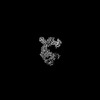 47042MC  9dngC C: citing same article ( M: map data used to model this data |
|---|---|
| Similar structure data | Similarity search - Function & homology  F&H Search F&H Search |
- Links
Links
- Assembly
Assembly
| Deposited unit | 
|
|---|---|
| 1 |
|
- Components
Components
| #1: Antibody | Mass: 23904.656 Da / Num. of mol.: 1 Source method: isolated from a genetically manipulated source Source: (gene. exp.)  Homo sapiens (human) / Production host: Homo sapiens (human) / Production host:  |
|---|---|
| #2: Antibody | Mass: 23209.820 Da / Num. of mol.: 1 Source method: isolated from a genetically manipulated source Source: (gene. exp.)  Homo sapiens (human) / Production host: Homo sapiens (human) / Production host:  |
| #3: Protein | Mass: 55727.160 Da / Num. of mol.: 1 / Mutation: M29W, H124I, R128L Source method: isolated from a genetically manipulated source Source: (gene. exp.)   |
| #4: Chemical | ChemComp-ODN / ( |
| Has ligand of interest | Y |
| Has protein modification | Y |
-Experimental details
-Experiment
| Experiment | Method: ELECTRON MICROSCOPY |
|---|---|
| EM experiment | Aggregation state: PARTICLE / 3D reconstruction method: single particle reconstruction |
- Sample preparation
Sample preparation
| Component | Name: Beta-arrestin 1 with insertion of soluble cytochrome b562 bound to anti-BRIL Fab Type: COMPLEX / Entity ID: #1-#3 / Source: RECOMBINANT |
|---|---|
| Source (natural) | Organism:  |
| Source (recombinant) | Organism:  |
| Buffer solution | pH: 7.5 |
| Specimen | Conc.: 7.5 mg/ml / Embedding applied: NO / Shadowing applied: NO / Staining applied: NO / Vitrification applied: YES |
| Vitrification | Instrument: FEI VITROBOT MARK IV / Cryogen name: ETHANE / Humidity: 100 % / Chamber temperature: 277 K |
- Electron microscopy imaging
Electron microscopy imaging
| Experimental equipment |  Model: Titan Krios / Image courtesy: FEI Company |
|---|---|
| Microscopy | Model: FEI TITAN KRIOS |
| Electron gun | Electron source:  FIELD EMISSION GUN / Accelerating voltage: 300 kV / Illumination mode: FLOOD BEAM FIELD EMISSION GUN / Accelerating voltage: 300 kV / Illumination mode: FLOOD BEAM |
| Electron lens | Mode: BRIGHT FIELD / Nominal defocus max: 2400 nm / Nominal defocus min: 800 nm |
| Image recording | Electron dose: 57 e/Å2 / Film or detector model: GATAN K3 (6k x 4k) |
- Processing
Processing
| EM software |
| |||||||||||||||||||||||||||||||||||
|---|---|---|---|---|---|---|---|---|---|---|---|---|---|---|---|---|---|---|---|---|---|---|---|---|---|---|---|---|---|---|---|---|---|---|---|---|
| CTF correction | Type: PHASE FLIPPING AND AMPLITUDE CORRECTION | |||||||||||||||||||||||||||||||||||
| 3D reconstruction | Resolution: 3.47 Å / Resolution method: FSC 0.143 CUT-OFF / Num. of particles: 177430 / Symmetry type: POINT | |||||||||||||||||||||||||||||||||||
| Atomic model building | 3D fitting-ID: 1 / Source name: PDB / Type: experimental model
|
 Movie
Movie Controller
Controller




 PDBj
PDBj


